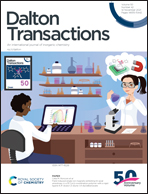Phosphine-catalysed reductive coupling of dihalophosphanes†
Abstract
Classically tetraaryl diphosphanes have been synthesized through Wurtz-type reductive coupling of halophosphanes R2PX or more recently, through the dehydrocoupling of phosphines R2PH. Catalytic variants of the dehydrocoupling reaction have been reported, but are limited to R2PH compounds. Using PEt3 as a catalyst, we now show that TipPBr2 (Tip = 2,4,6-iPr3C6H2) is selectively coupled to give the dibromodiphosphane (TipPBr)2 (1), a compound not accessible using classic Mg reduction. Surprisingly, when using DipPBr2 (Dip = 2,6-iPr3C6H3) in the PEt3 catalysed reductive coupling the diphosphene (PDip)2 (2) with a P![[double bond, length as m-dash]](https://www.rsc.org/images/entities/char_e001.gif) P double was formed selectively. In benzene solutions (PDip)2 has a half life time of ca. 28 days and can be utilized with NHCs to access NHC-phosphinidene adducts. To show that this protocol is more widely applicable, we show that Ph2PCl and Mes2PX (X = Cl, Br) are efficiently coupled using 10 mol% of PEt3 to give (Ph2P)2 and (Mes2P)2, respectively. Control experiments show that [BrPEt3]Br is a potential oxidation product in the catalytic cycle, which can be debrominated by Zn dust as a sacrificial reductant.
P double was formed selectively. In benzene solutions (PDip)2 has a half life time of ca. 28 days and can be utilized with NHCs to access NHC-phosphinidene adducts. To show that this protocol is more widely applicable, we show that Ph2PCl and Mes2PX (X = Cl, Br) are efficiently coupled using 10 mol% of PEt3 to give (Ph2P)2 and (Mes2P)2, respectively. Control experiments show that [BrPEt3]Br is a potential oxidation product in the catalytic cycle, which can be debrominated by Zn dust as a sacrificial reductant.



 Please wait while we load your content...
Please wait while we load your content...